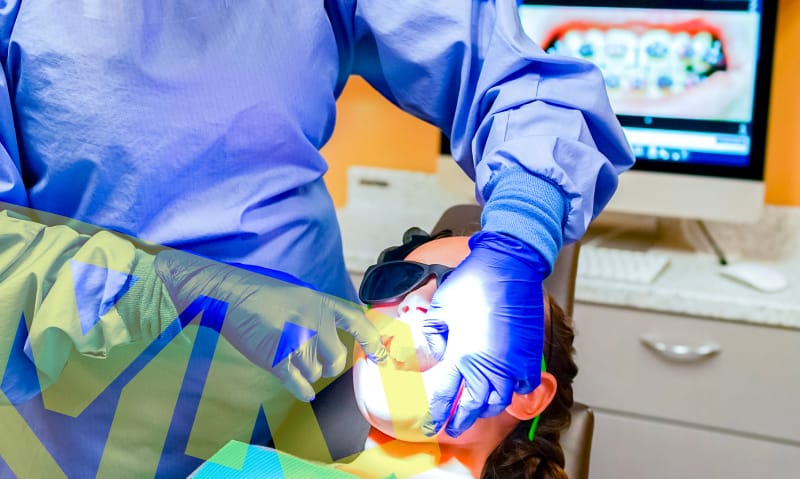Introduction to 2-Phase Orthodontic Treatment Plans

Understanding Phases 1 & 2 of Kids’ Orthodontics
Quick! What comes to mind when you think about orthodontic care? Braces, right? Most adults are often surprised to learn that these metal brackets or their counterpart, clear aligners, aren’t the only orthodontic treatments available for kids.
Two-phase treatment is a specialized orthodontic treatment that combines teeth straightening with the realignment of developing intraoral facial structures. Here’s a quick look at what phase 1 and phase 2 of this treatment looks like.
What is phase 1 orthodontic treatment?
Phase 1 orthodontic treatment, otherwise known as early interceptive treatment, is concerned with three things:
- Preventing a dental problem from developing
- Intercepting a future issue
- Guiding the growth of the jawbones that support teeth
Kids can start showing signs of jaw problems from as early as five years of age. So in cases where the upper and lower jaws of a child grow too much or not enough, phase 1 orthodontic treatment can help rectify the situation. Such early correction prevents future removal of permanent teeth due to overcrowding and sometimes makes the need for surgical procedures to fix jaw misalignment unnecessary.
On the other hand, early interceptive treatment is not recommended unless your child’s dentist is sure that your child’s jaw issues will negatively impact the growth and development of their teeth, gums, jaws, and face if the problem isn’t rectified.
That’s why pediatric dentists perform orthodontic evaluations on children at age six or seven, around the time all their baby teeth have erupted. During this initial consultation, your child’s dental health professional will take X-rays and photos of your little one’s teeth and jaw to determine if they foresee any future developmental issues.
Common Orthodontic Therapies Used in Phase 1
Because early interceptive treatments rely on the predictable stages of dental development to provide the greatest potential for improvement and correction of your child’s malocclusion, dentists can often make use of a number of orthodontic therapies. Palatal expanders, for instance, can help widen the arch in the upper jaw so your child won’t need to have extractions to create more jaw space to accommodate larger permanent teeth. This device will also allow any impacted teeth to break through the gumline and into proper position by itself.
For kids who prematurely lose baby teeth either because of decay or trauma, a space maintainer can help hold the space until the permanent tooth is ready to erupt. If your little one’s thumbsucking habit or pacifier use extends past the age of five, the upper arch may narrow and an anterior open bite can develop. Using a dental device like a tongue crib for three to six months can prove highly effective at weaning your child off this habit.
What is phase 2 orthodontic treatment?
The goal of phase 2 treatments is to establish a proper relationship between the teeth and jaw to ensure the teeth function together properly and create a beautiful smile. It’s in this phase where the treatment plan designed in phase 1 may need to be fine-tuned to include any changes that may have happened between phase 1 and now.
Phase 2 usually takes place when your child has most or all of their permanent teeth, which is typically around the age of 12 or 13. Whether or not the second phase is necessary depends on your child’s current dentition and smile goals.
Common Orthodontic Therapies Used in Phase 2
The main therapy used in phase 2 is what most of us are familiar with: braces. Your dentist will attach metal brackets to each tooth and connect them with a special wire. This wire is what’s adjusted periodically to add pressure to the teeth and move them into their proper position.
Occasionally, braces may also include rubber bands, coils, or spring braces to provide extra force when alignment issues are severe. Once treatment is complete, your child will move on to a retainer to make sure their teeth stay in their newly straightened positions long term.
Signs Your Child Needs Two-Phase Orthodontic Treatment
Orthodontic care is never a “one-size-fits-all” solution; sometimes the treatment is right for a patient, but the patient isn’t right for the treatment. Nonetheless, there are a couple of telltale signs that may point to a need for two-phase orthodontic treatment, including protruding upper or lower teeth, an early loss of baby teeth, or teeth that don’t come together properly when the mouth closes.
Of course, every case is different, and you’ll need to schedule an appointment with a pediatric dentist for a professional examination to determine if there’s even a need for phase 1 treatment. If there is, Dr. Mo will walk you through what happens during a two-phase orthodontic treatment as well the therapies that best suit your child’s particular needs.
Visit our office today and give your little one the best chance at a healthy, beautiful smile!